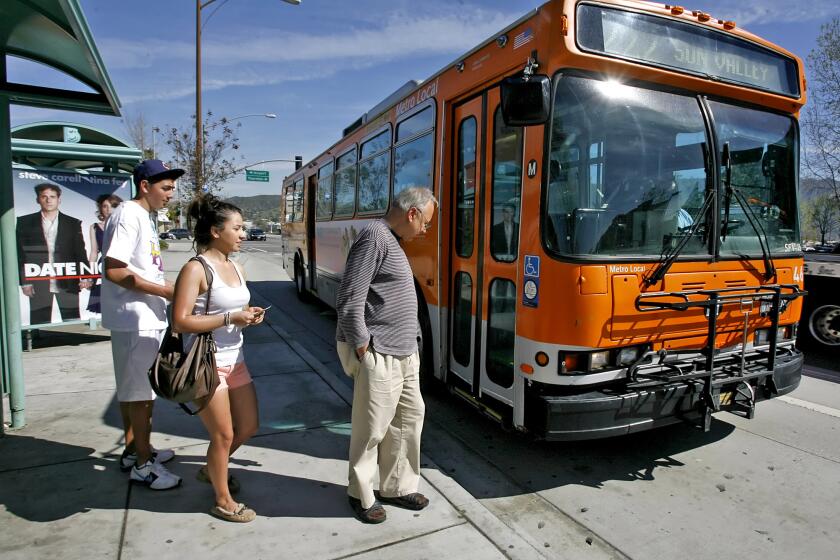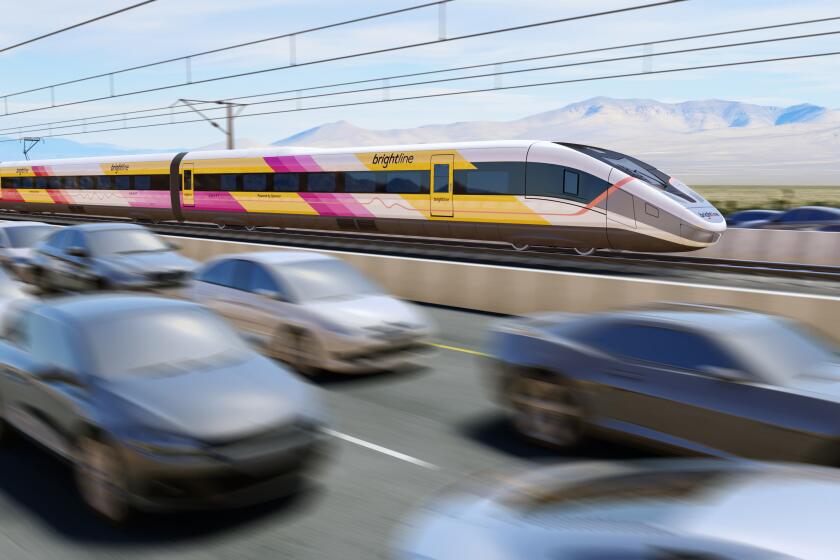L.A., on a faster track
Union Station, filled on a typical afternoon with a mixture of Amtrak passengers, Metro commuters and curious tourists, often feels more like a stage set -- a place playing at sophistication and an old-fashioned, genteel kind of urbanity -- than a transportation hub. Maybe that has something to do with how many movies and television shows have used the building, which was designed in streamlined Mission Revival style by John and Donald Parkinson and opened in 1939, as a backdrop. Maybe it’s just that the station, though sometimes moderately busy, is rarely packed or fully animated by a thronging crowd the way the most memorable urban spaces are.
All that may change, however, if the state of California, after years of toying with the idea, manages to put a high-speed rail system into operation. Proposition 1A is a statewide initiative seeking to raise $10 billion as a down payment for a bullet-train route that could ultimately stretch from Sacramento to San Diego. Total costs to the state would be roughly $45 billion, with complementary funding coming from the federal government and private investors.
Union Station would serve as the terminus of the train’s San Francisco to Los Angeles leg, which promises to be, from its first day, one of the busiest rail routes in the country. Advocates of the bullet train estimate that total state ridership could be as high 117 million passengers annually. Even if the actual numbers were somewhat lower, the effect on the area immediately surrounding Union Station, and on downtown as a whole, promises to be huge.
Once the bullet train started dropping passengers at the city’s doorstep, the neighborhood around the station would instantly see new shops and restaurants as well as commercial and retail development. L.A. residents who might otherwise never ride the Metro would use it to reach Union Station in order to catch the train. Just as important, the city would essentially be forced to address the abysmal pedestrian connections that exist between Union Station and the rest of downtown. The station, separated by the 101 Freeway from the downtown core, now feels marooned. Walking from there to the Civic Center, a trip I’ve made frequently from the end of the Gold Line to the Times building, is a dramatic way to approach the downtown skyline. It is also a less-than-romantic trek across overpasses and along crumbling, forsaken sidewalks.
Electrically powered and using “steel-wheel on steel-track” technology, rather than the mag-lev system briefly considered by the state, the bullet train could reach speeds as high as 220 mph, whisking passengers from downtown San Francisco to downtown Los Angeles in less than three hours for an estimated $55 each way in today’s dollars. Opponents of the bullet train, including James Moore, director of USC’s transportation engineering program, have argued that travel times would be longer than that and ticket prices significantly higher. Others guess that the state’s tab would be not $45 billion but roughly $80 billion.
Still, it seems increasingly obvious that if we don’t fund high-speed rail now, we will have to pay an even higher price, as the state’s population continues to grow, to subsidize freeway and airport construction. The question is not whether we are going to fund transportation projects over the next two decades. The question is which ones, and when -- and whether we will have the foresight to understand that the benefits of high-speed rail are about not just convenience, mobility and air quality but also the health and character of our cities.
As a neighborhood, downtown Los Angeles has long struggled with an existential crisis about what kind of role it plays, or is capable of playing, in the L.A. region. If it has never been the true center of Los Angeles, its beating heart, it is certainly first among equals when it comes to urban nodes here. And it is undeniably central in terms of transportation -- the one place in L.A. where freeways, bus lines, subways and several varieties of rail come together. In that sense, the bullet train could make downtown’s transit centrality, well, bulletproof. Building downtown’s identity through transit is also a more efficient, and more intelligent, strategy for urban revitalization than the ones we have typically relied on in Los Angeles.
Half a century of loading Bunker Hill and other parts of downtown with gleaming, stand-alone mega-projects -- with more to come, if the economy ever begins cooperating again -- has done little to stitch together the area’s constituent parts in any meaningful way. The effect of the $2.5-billion L.A. Live development on the rest of downtown, for example, will probably be minimal, since its shops, theaters and restaurants are primarily designed to attract people from around the city arriving by car.
The bullet train could bring literally millions of new transit users into downtown every year. As I wrote Thursday about L.A. County’s Measure R, transit users are also, in virtually every case, urban pedestrians. They are among the most sophisticated observers of how the city is designed and maintained. Instead of seeing shared space at a remove, the way drivers do, they understand it on a block-by-block basis.
Downtown is already feeling more vital than it has for decades as its residential population continues to grow. But its maturation has been painfully slow. The arrival of the bullet train could accelerate it significantly. The train could help downtown achieve a critical mass of foot traffic, which would in turn lure new development -- as well as boosting safety and creating a constituency for streetscape improvements.
State propositions are hardly the most efficient means of crafting transit policy. But decades of dithering in Sacramento mean that it has been left to us, the voters, to send a message with Proposition 1A that we are desperate for a comprehensive public-transportation system in this city and this state.
A yes vote doesn’t mean that you endorse every bend in the bullet train’s planned route or every penny of its financing strategy. It simply means that you want to give momentum to the notion that California needs high-speed rail as soon as reasonably possible, and that you think this is a project worth significant state investment. And investment is the right word, since the train could begin to turn a sizable profit for Sacramento within a few years of operation.
I like the sleepiness of Union Station, its charming, time-warp appeal. But I like the idea of a bullet train -- and what it could mean for the vitality of downtown Los Angeles -- a whole lot more.
--
christopher.hawthorne @latimes.com
More to Read
Start your day right
Sign up for Essential California for news, features and recommendations from the L.A. Times and beyond in your inbox six days a week.
You may occasionally receive promotional content from the Los Angeles Times.







